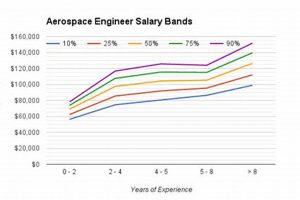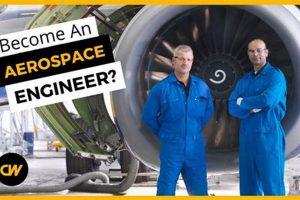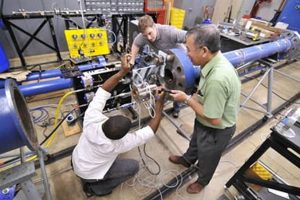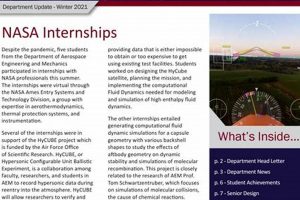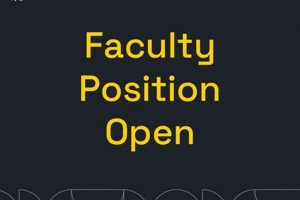Institutions offering superior education in the design, development, and testing of aircraft and spacecraft represent a pivotal stepping stone for aspiring professionals in the aerospace sector. These establishments are characterized by rigorous curricula, cutting-edge research facilities, and faculty composed of leading experts in various fields, from aerodynamics to propulsion systems. A strong emphasis is placed on hands-on experience through laboratory work, design projects, and often, industry internships, providing students with practical skills and insights.
Attending a highly regarded program can significantly impact a graduate’s career trajectory, opening doors to competitive positions in aerospace companies, government agencies, and research institutions. The reputation of a particular university can signal to employers a certain level of competence and preparedness. Furthermore, the historical context of aerospace education reveals a constant evolution, driven by advancements in technology and the increasing complexity of aerospace challenges. From early pioneers experimenting with flight to the modern era of space exploration, academic institutions have played a central role in fostering innovation and training the next generation of engineers.
The following sections will explore specific criteria used to evaluate these programs, including factors such as faculty expertise, research opportunities, industry connections, and student outcomes. Rankings and methodologies employed by various organizations will be analyzed, and insights provided into navigating the application process and maximizing the benefits of an aerospace engineering education.
Prospective students aiming for elite aerospace engineering programs should implement strategic preparation and informed decision-making throughout their academic journey.
Tip 1: Cultivate a Strong Foundation in STEM: Excellence in mathematics and physics is paramount. Prioritize advanced coursework in these areas throughout high school and consider participating in relevant extracurricular activities like math or science competitions.
Tip 2: Emphasize Relevant Extracurricular Activities: Participation in aerospace-related clubs, robotics teams, or science olympiads demonstrates a genuine interest and provides valuable hands-on experience. Seek out opportunities to build model rockets, design drones, or engage in coding projects with aerospace applications.
Tip 3: Seek Research Opportunities Early: Actively pursue research experiences with university professors or at research institutions. Even entry-level research can showcase initiative and provide exposure to advanced concepts in aerospace engineering.
Tip 4: Focus on a Rigorous Curriculum: Select challenging coursework, including advanced placement (AP) or International Baccalaureate (IB) classes, to demonstrate academic preparedness. A strong academic record is a crucial factor in the admissions process.
Tip 5: Develop Strong Communication Skills: Aerospace engineers must effectively communicate complex technical information. Focus on developing both written and oral communication skills through class presentations, writing assignments, and public speaking opportunities.
Tip 6: Consider Location Strategically: proximity to aerospace hubs is benificial. Explore colleges near aerospace-dense regions and those with strong co-op and internship affiliations with leading aerospace companies.
Tip 7: Understand Admission Statistics: Analyze the average GPA, standardized test scores, and acceptance rates of preferred institutions. This insight allows for a more realistic assessment of admission prospects and the strategic diversification of application choices.
Preparation and proactive engagement are critical for gaining admission to competitive programs. A multifaceted application, demonstrating academic excellence, practical experience, and genuine passion, is essential for success.
The subsequent portion of this article will address the long-term career prospects associated with graduating from a well-regarded aerospace engineering program.
1. Faculty Expertise
The proficiency and dedication of faculty members constitute a cornerstone element distinguishing top-tier aerospace engineering programs. Their qualifications, research contributions, and commitment to instruction profoundly impact the quality of education and the preparedness of graduates.
- Research Contributions and Scholarly Impact
Faculty at leading aerospace engineering institutions are frequently at the forefront of their respective fields, contributing significantly to the body of knowledge through peer-reviewed publications, conference presentations, and patented inventions. Their research informs course content, exposes students to cutting-edge concepts, and provides opportunities for direct participation in groundbreaking projects. The citation impact of faculty publications and their recognition through prestigious awards serve as indicators of scholarly influence and academic standing.
- Industry Experience and Practical Application
Many faculty members possess prior experience working in the aerospace industry or government research laboratories. This practical background allows them to bridge the gap between theory and application, providing students with real-world insights and perspectives. They often incorporate case studies, design projects, and industry-sponsored research into their courses, enabling students to develop problem-solving skills applicable to contemporary aerospace challenges.
- Instructional Pedagogy and Mentorship
Effective teaching extends beyond the dissemination of technical information. Faculty at the premier programs employ diverse pedagogical approaches to engage students and foster a deep understanding of complex concepts. They serve as mentors, guiding students in their academic and career development, providing advice on research opportunities, internships, and postgraduate studies. Accessibility and willingness to support student learning are hallmarks of outstanding faculty members.
- Areas of Specialization and Expertise Diversity
The breadth and depth of faculty expertise across various aerospace disciplines, such as aerodynamics, propulsion, structures, and control systems, are critical to offering a comprehensive curriculum. Institutions with diverse faculty backgrounds can provide specialized instruction in emerging areas, like space robotics, autonomous systems, and advanced materials. This specialization enables students to tailor their studies to specific interests and career goals.
In summary, faculty expertise is a critical component in evaluating the institutions. The research prominence, practical exposure, instructional skills, and specialized backgrounds of the faculty shape the overall learning environment and contribute substantially to the quality of the degree, impacting future career success.
2. Research Funding
Research funding serves as a crucial determinant in differentiating top-tier aerospace engineering programs. The availability and magnitude of financial resources directly influence the breadth and depth of research activities, faculty recruitment, and the overall learning environment within an institution.
- Advanced Research Infrastructure
Substantial research funding enables institutions to acquire and maintain state-of-the-art equipment and facilities, including wind tunnels, propulsion test stands, materials characterization labs, and computational resources. These advanced tools are essential for conducting cutting-edge research in areas such as hypersonics, advanced materials, and autonomous systems. Access to these resources enhances the learning experience for students, allowing them to engage in hands-on research and develop practical skills relevant to the aerospace industry. For example, a university with a well-funded hypersonics lab can offer students unique opportunities to participate in experiments involving high-speed flight and thermal protection systems, fostering innovation and expertise in this critical area.
- Faculty Recruitment and Retention
Competitive research funding packages attract and retain leading faculty members, who are often at the forefront of their respective fields. Renowned researchers bring prestige to the institution, enhance its reputation, and attract high-caliber students. Moreover, research grants often provide funding for graduate student stipends and research assistantships, fostering a vibrant research community and providing students with valuable mentorship opportunities. Top aerospace engineering programs consistently invest heavily in attracting and supporting faculty who can drive innovation and attract external funding.
- Industry Collaboration and Technology Transfer
Research funding often facilitates collaborations between universities and aerospace companies, fostering technology transfer and enabling the development of practical solutions to industry challenges. Collaborative research projects provide students with exposure to real-world problems and opportunities to work alongside industry professionals. This collaboration can lead to internships, job opportunities, and the development of innovative technologies that benefit both the academic and industrial sectors. For example, a university with strong industry partnerships may collaborate with a major aerospace manufacturer to develop new composite materials for aircraft structures, resulting in improved performance and fuel efficiency.
- Student Research Opportunities and Experiential Learning
Ample research funding creates abundant opportunities for undergraduate and graduate students to participate in research projects, design competitions, and other experiential learning activities. These experiences allow students to apply theoretical knowledge to practical problems, develop critical thinking skills, and gain valuable research experience that enhances their career prospects. Students who engage in research during their academic careers are often more competitive in the job market and better prepared for advanced studies. Well-funded aerospace engineering programs prioritize providing students with opportunities to participate in research projects, design teams, and other extracurricular activities that complement their classroom learning.
The link is that higher funding leads to superior facilities, faculty, and opportunities. This further elevates the quality and prestige of those “institutions”.
3. Industry partnerships
A synergistic relationship exists between prominent aerospace engineering programs and industry stakeholders. These alliances are not merely symbolic; they represent a vital exchange of knowledge, resources, and talent that directly benefits both the academic institution and the aerospace sector. The strongest programs actively cultivate these partnerships to ensure their curriculum remains current, relevant, and aligned with industry needs. This connection manifests in several forms, including collaborative research projects, sponsored design challenges, and internship opportunities for students. For instance, Boeing’s long-standing relationship with universities like the University of Washington has led to joint research initiatives in areas such as advanced composite materials and sustainable aviation technologies. Similarly, Lockheed Martin’s investment in programs at Georgia Tech provides students with access to real-world engineering challenges and potential career paths.
The advantages extend beyond immediate research outcomes. Industry partnerships provide crucial feedback on curriculum development, ensuring that graduates possess the specific skills and knowledge sought by employers. Companies often participate in advisory boards, offering guidance on emerging trends and future workforce requirements. Furthermore, these collaborations can translate into valuable resources for the university, including access to proprietary software, specialized equipment, and guest lectures from industry experts. For example, a partnership between an aerospace manufacturer and an engineering program could involve the donation of a retired aircraft for use in structural testing or the provision of specialized simulation software for aerodynamic analysis. This direct engagement equips students with practical experience and enhances their employability.
In essence, robust industry partnerships are a hallmark of a leading aerospace engineering program. They provide a crucial bridge between academic theory and real-world application, fostering innovation, enhancing the student experience, and ultimately ensuring a pipeline of highly skilled engineers ready to contribute to the advancement of the aerospace industry. Institutions lacking these strong connections face a disadvantage in preparing students for the demands of a rapidly evolving field.
4. Curriculum Rigor
Curriculum rigor within elite aerospace engineering programs functions as a key determinant of graduate competence and their subsequent contributions to the field. The intensity and depth of the academic coursework are directly correlated with the program’s ability to equip students with the complex skills and knowledge necessary for success in a demanding profession.
- Emphasis on Foundational Sciences and Mathematics
The cornerstone of a rigorous aerospace engineering curriculum resides in its demanding approach to foundational sciences and mathematics. Courses in advanced calculus, differential equations, linear algebra, physics, and chemistry are not merely introductory but are treated as essential tools for tackling complex engineering challenges. For example, a course in fluid dynamics necessitates a deep understanding of partial differential equations to accurately model airflow around an aircraft. A stringent focus on these fundamentals ensures students possess the analytical skills needed to approach novel problems and adapt to emerging technologies.
- Advanced Coursework in Core Aerospace Disciplines
Beyond the basics, a rigorous curriculum delves into the core disciplines of aerospace engineering: aerodynamics, propulsion, structures, and control systems. These courses should extend beyond introductory concepts, incorporating advanced topics such as computational fluid dynamics, rocket propulsion principles, finite element analysis, and modern control theory. For instance, a structures course would not only cover basic stress analysis but also explore composite materials, fracture mechanics, and advanced structural design techniques. This advanced material challenges students to think critically and apply their knowledge to complex engineering problems.
- Design Projects and Hands-on Experience
Curriculum rigor is significantly enhanced by incorporating extensive design projects and hands-on experience. These elements provide students with opportunities to apply theoretical knowledge to real-world engineering scenarios. Examples include designing and building model aircraft, conducting wind tunnel testing, developing control algorithms for unmanned aerial vehicles, or participating in aerospace design competitions. These experiences foster innovation, problem-solving skills, and teamwork abilities, all of which are highly valued by employers. The integration of software tools used in the industry, such as CAD/CAM packages and simulation software, is also essential in bridging the gap between theory and practice.
- Integration of Emerging Technologies and Interdisciplinary Studies
A rigorous aerospace engineering curriculum should not remain static but must evolve to incorporate emerging technologies and interdisciplinary studies. This includes topics such as artificial intelligence, robotics, nanotechnology, and sustainable engineering. For instance, the integration of AI into autonomous flight control systems or the application of nanotechnology to create stronger and lighter aerospace materials represents cutting-edge areas of research and development. Furthermore, fostering interdisciplinary collaboration between aerospace engineering and other fields, such as computer science, materials science, and environmental science, broadens the students’ perspective and prepares them for the increasingly complex challenges facing the aerospace industry.
In conclusion, a strong core foundation, a rigorous emphasis in key aerospace concepts, hands-on learning, and an adaptive course that evolves with emerging technologies, best represents the high quality, intense preparation necessary to become competitive. The presence and intensity of these elements within an aerospace program are central to its ability to nurture future innovators and leaders in the industry.
5. Facilities Quality
The caliber of facilities within aerospace engineering programs serves as a tangible indicator of an institution’s commitment to excellence and its capacity to foster innovation. Superior facilities are not merely aesthetic additions; they represent a strategic investment in the educational ecosystem, directly influencing research capabilities, hands-on learning opportunities, and the overall student experience. Access to advanced laboratories, wind tunnels, flight simulators, and computational resources provides students and faculty with the necessary tools to conduct cutting-edge research, test new designs, and develop practical solutions to complex aerospace challenges. For instance, a university possessing a hypersonic wind tunnel allows for experimentation and validation of designs for high-speed vehicles, offering a distinct advantage in a competitive research landscape. Therefore, “facilities quality” is a significant component when evaluating “best aerospace engineering colleges”.
The availability of specialized equipment and dedicated spaces facilitates experiential learning, enabling students to translate theoretical knowledge into practical skills. Well-equipped machine shops, composite materials labs, and electronics fabrication facilities allow students to build and test prototypes, conduct experiments, and develop a deeper understanding of the manufacturing processes involved in aerospace engineering. Such hands-on experiences are invaluable in preparing graduates for the demands of the industry, where problem-solving, critical thinking, and practical skills are highly valued. Moreover, high-quality facilities attract top faculty members, who are drawn to institutions where they can pursue their research interests and collaborate with talented students. The presence of renowned researchers and experienced instructors further enhances the learning environment and contributes to the overall reputation of the program. For example, the presence of state-of-the-art propulsion testing facilities at Purdue University has helped attract leading experts in combustion and rocket propulsion, establishing the university as a hub for research and education in these critical areas.
In conclusion, the quality of facilities is an essential criterion in assessing an aerospace engineering program’s standing. It directly impacts research capabilities, student learning, and faculty recruitment. Institutions that prioritize investment in modern, well-equipped facilities demonstrate a commitment to providing students with a world-class education and preparing them for leadership roles in the aerospace industry. Conversely, programs lacking adequate facilities may struggle to attract top talent, conduct cutting-edge research, and equip graduates with the skills necessary to succeed in a competitive field.
6. Graduate placement
Graduate placement rates and the quality of initial employment opportunities serve as pivotal metrics in evaluating the efficacy of aerospace engineering programs. The correlation between an institution’s reputation and the career trajectories of its graduates underscores the significance of placement as a key indicator of program success.
- Direct Recruitment by Aerospace Companies
Institutions recognized for excellence in aerospace engineering often experience direct recruitment efforts from leading companies in the sector. These companies, including Boeing, Lockheed Martin, SpaceX, and Northrop Grumman, prioritize graduates from specific programs due to their demonstrated preparedness and skill sets. On-campus recruitment events, dedicated career fairs, and partnerships with industry facilitate this direct pipeline. For example, a high percentage of graduates from MIT and Caltech are directly recruited into advanced engineering roles within these organizations, bypassing initial screening processes due to the reputation of their alma mater.
- Acceptance into Prestigious Graduate Programs
Graduate placement extends beyond immediate employment; it also encompasses acceptance into highly competitive graduate programs. Graduates from top aerospace engineering programs are frequently admitted to advanced degree programs at peer institutions, reflecting the rigorous preparation and academic foundation they have received. A high rate of acceptance into doctoral programs and competitive fellowships indicates that the program has instilled a strong research aptitude and a commitment to advancing the field. The University of Michigan, for instance, consistently places its aerospace engineering graduates into top-tier doctoral programs, signifying the strength of its research-oriented curriculum.
- Starting Salaries and Career Advancement
Initial compensation and long-term career progression are tangible indicators of successful graduate placement. Graduates from well-regarded aerospace engineering programs typically command higher starting salaries compared to their counterparts from less prestigious institutions. Furthermore, they often experience faster career advancement, assuming leadership roles and contributing to innovative projects within their organizations. Salary surveys and alumni networks provide data points for assessing these metrics, revealing the economic value associated with graduating from a top program. Data consistently show that graduates from Stanford and Georgia Tech earn above-average starting salaries and achieve accelerated career trajectories within the aerospace industry.
- Geographic Distribution and Industry Impact
The geographic distribution of graduates and their contributions to the aerospace industry provide insights into the program’s overall impact. Top programs tend to produce graduates who are distributed across various sectors of the aerospace industry, contributing to research, development, and engineering efforts both domestically and internationally. Their involvement in significant projects, patent filings, and publications reflects the program’s ability to cultivate innovative and influential professionals. For example, a high concentration of graduates from the University of Colorado Boulder working at NASA centers and aerospace startups demonstrates the program’s contribution to the advancement of space exploration and technology.
These facets illustrate how successful graduate placement is intrinsically linked to institutional standing, contributing to a positive feedback loop. The consistent success of alumni reinforces the program’s reputation, attracting talented students and fostering stronger industry connections, thereby perpetuating the cycle of excellence. As a result, “Graduate placement” has to be one of the main metrics when evaluating “best aerospace engineering colleges”.
7. Program Reputation
Program reputation serves as a significant, albeit qualitative, factor in determining institutions recognized for aerospace engineering education. It represents the culmination of various elements discussed previously, reflecting the perceived quality, influence, and standing of a particular program within the academic and professional aerospace communities. This perception influences student recruitment, faculty retention, research funding, and ultimately, graduate career prospects.
- Influence on Employer Perception
A strong program reputation directly translates to enhanced employer perception. Companies actively seek graduates from well-regarded institutions, viewing them as possessing a higher level of competence, preparation, and potential. This preferential treatment can manifest in higher starting salaries, more challenging assignments, and accelerated career advancement opportunities. For example, graduating from an aerospace engineering program consistently ranked among the top five can significantly improve a candidate’s chances of securing a coveted position at a leading aerospace firm or government research laboratory. The perceived quality of education becomes a proxy for demonstrated skills and knowledge.
- Attraction of High-Caliber Students and Faculty
Program reputation operates as a self-reinforcing cycle, attracting high-achieving students and accomplished faculty members. Prospective students are drawn to programs known for their academic rigor, research opportunities, and career placement rates. Similarly, leading researchers and instructors are more likely to affiliate with institutions that offer a supportive research environment, competitive salaries, and opportunities for professional growth. The presence of talented students and faculty further enhances the program’s reputation, creating a virtuous cycle of excellence. Highly ranked programs benefit from a larger pool of qualified applicants, allowing them to select the most promising students and build a diverse and intellectually stimulating learning environment.
- Impact on Research Funding and Grants
Program reputation plays a critical role in securing research funding and grants from government agencies, private foundations, and industry partners. Funding organizations often prioritize proposals from institutions with established track records of research excellence and a reputation for producing impactful results. A strong program reputation lends credibility to research proposals, increasing the likelihood of securing funding for ambitious projects and attracting top-tier researchers. The ability to secure external funding further enhances the program’s research capabilities, allowing it to acquire state-of-the-art equipment, support graduate students, and conduct groundbreaking research in areas of strategic importance to the aerospace industry.
- Influence on Academic Rankings and Recognition
Program reputation is a key component in many academic ranking methodologies, influencing an institution’s overall standing and visibility. Rankings often incorporate surveys of academics and industry professionals, assessing the perceived quality and influence of different programs. While rankings should not be the sole determinant of program selection, they can provide a useful benchmark for comparing institutions and identifying programs with a strong reputation for excellence. High rankings can attract more applicants, improve fundraising efforts, and enhance the institution’s overall prestige. However, it is essential to recognize that rankings are based on subjective assessments and may not fully capture the nuances of program quality. Focusing on the underlying factors that contribute to program reputation, such as faculty expertise, research output, and graduate placement rates, provides a more comprehensive evaluation of an institution’s strengths.
In summary, while program reputation is often subjective and influenced by various external factors, it significantly shapes the perception of program quality. As a qualitative metric, this impacts various aspects of the institution, playing a pivotal role in the cycle of success and the ability to improve and compete in the academic and professional arenas. Therefore, “Program reputation” becomes inextricably linked to the concept of “best aerospace engineering colleges.”
Frequently Asked Questions
This section addresses common inquiries regarding the selection, evaluation, and benefits of attending a leading aerospace engineering college. The information provided aims to clarify misconceptions and provide actionable guidance for prospective students and stakeholders.
Question 1: What constitutes a “best aerospace engineering colleges” in objective terms?
The assessment of premier programs involves analyzing several key metrics, including faculty expertise (publications, research grants), research funding (total expenditure, source diversity), industry partnerships (collaborative projects, recruitment rates), curriculum rigor (course depth, design projects), facilities quality (laboratories, wind tunnels), graduate placement (employment rates, starting salaries), and overall program reputation (peer reviews, rankings). The weighting of these factors may vary depending on individual priorities.
Question 2: How significant are college rankings in determining the quality of aerospace engineering programs?
While rankings offer a comparative overview, they should not be the sole determinant in program selection. Rankings often rely on subjective assessments and may not fully capture the nuances of program strengths. A comprehensive evaluation should also consider factors such as specific research interests, desired learning environment, and career goals.
Question 3: What are the primary career paths available to graduates of top aerospace engineering programs?
Graduates pursue diverse career paths within the aerospace industry and related fields. These include roles in aircraft and spacecraft design, propulsion systems development, control systems engineering, structural analysis, research and development, and project management. Opportunities also exist in government agencies, consulting firms, and the defense sector.
Question 4: What can prospective students do to enhance their chances of admission to premier aerospace engineering programs?
Applicants should cultivate a strong foundation in mathematics and physics, participate in relevant extracurricular activities (e.g., robotics teams, science olympiads), seek research opportunities, emphasize a rigorous curriculum (AP/IB courses), and develop strong communication skills. Demonstrating a genuine passion for aerospace engineering through involvement in related projects and activities is also crucial.
Question 5: How important are internships and co-op programs in aerospace engineering education?
Internships and co-op programs provide invaluable hands-on experience and exposure to real-world engineering challenges. These experiences enhance students’ technical skills, professional networks, and career prospects. A program’s strong industry connections and availability of internship opportunities should be a significant consideration.
Question 6: What is the long-term value of attending a highly-regarded aerospace engineering program?
Graduates of top programs often experience higher earning potential, accelerated career advancement, and increased opportunities to contribute to impactful research and development projects. The network of alumni and faculty connections provides ongoing support and mentorship throughout their careers. The reputation of the program also signals a certain level of competence and preparedness to potential employers.
In summary, selecting a premier aerospace engineering program requires a careful and informed assessment of various factors, including academic rigor, research opportunities, industry connections, and career outcomes. Rankings offer a starting point, but a comprehensive evaluation should consider individual priorities and goals.
The final section of this article will provide a summary of the key takeaways and offer concluding remarks.
Conclusion
The preceding analysis emphasizes multifaceted evaluation of institutions aspiring to be defined as “best aerospace engineering colleges.” The rigorous assessment encompasses faculty expertise, research funding, industry partnerships, curriculum rigor, facilities quality, graduate placement, and program reputation. A comprehensive understanding of these intertwined elements is critical for prospective students, academic institutions, and industry stakeholders seeking to cultivate excellence within the aerospace engineering domain.
The pursuit of preeminence in aerospace engineering education necessitates a continuous commitment to innovation, collaboration, and rigorous academic standards. The future of aerospace advancement hinges on the cultivation of talent within these distinguished programs, ensuring a steady influx of skilled engineers poised to address the complex challenges and transformative opportunities that lie ahead. Investment in and commitment to, robust aerospace engineering programs remains critical for continued innovation and progress.



